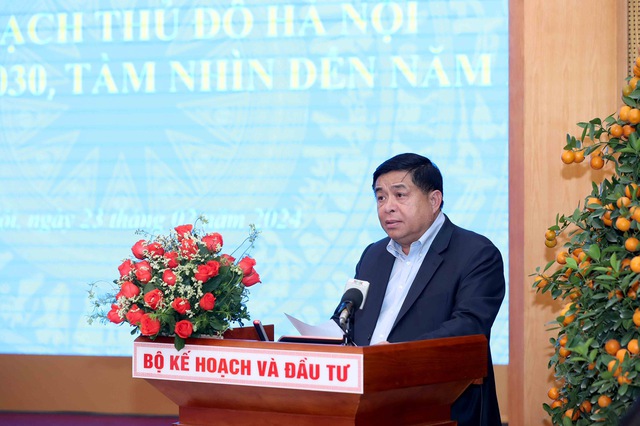Challenges and Development Opportunities in Hanoi
During the meeting, Minister of Planning and Investment Nguyen Chi Dung pointed out that Hanoi still faces several difficulties, challenges, and “bottlenecks” that need to be addressed. The economic position of Hanoi tends to decline compared to other provinces and cities in the Red River Delta region. The GRDP growth rate in 2023 is projected to reach only 6.27%, ranking 9th out of 11 provinces and cities in the Red River Delta region.

Minister Nguyen Chi Dung believes that the city’s planning needs to address the current development bottlenecks in Hanoi.
The city still faces many challenges in terms of technical infrastructure and social infrastructure development (transportation, electricity, energy, information, communication, water supply and drainage, education, training, healthcare, culture, and social services). The major issues are traffic congestion, environmental pollution, and flooding. The transportation network within the infrastructure system has not been developed systematically, especially lacking north-south and east-west routes.
In addition, the connection between Hanoi and the Red River Delta provinces, especially the provinces in the southern region, has not been synchronized and developed adequately. The population scale of Hanoi has exceeded the projected level due to natural population growth, and relocating people from the inner city is infeasible, creating significant pressure on infrastructure and the living quality of residents.
In order to achieve sustainable development, Hanoi needs to identify its unique potentials, distinctive strengths, and outstanding attributes. The current planning must introduce new approaches, new thinking, expand the development perspective, and provide a clear implementation roadmap.
According to the Ministry of Planning and Investment, the Capital Planning of Hanoi has proposed new breakthrough points in the development direction. Specifically, Hanoi determines the direction of becoming the leading center for semiconductor industry, information technology and artificial intelligence, biotechnology, and the development of high-tech agricultural products and leading crop varieties in the northern provinces.
The Red River: The Main Driving Force for Hanoi’s Development
The organization of Hanoi’s development space includes five driving forces, with the Red River as the main driving force, a focal point of the urban area connecting the southern and northern urban areas along the Red River. The orientation is to establish cultural, festival, sports, tourist, night-time economic and service centers, accommodation, resorts, and elderly care facilities along both sides of the river.
Efficient exploitation of the 5 corridors and the economic belt of the Capital City of Hanoi truly becomes a convergence hub, a connecting center, a driving force for internal and inter-regional and inter-provincial areas, and plays an important role in connecting with other provinces and cities in the Red River Delta region, the Capital City region, the Central-Northern region, and towards international gateways and seaports.
Harmonious organization and reasonable exploitation of the 5 development spaces and the development model of the Capital City, including 1 central urban area and 4 cities under the Capital, should be emphasized. Developing the urban system and organizing the territory under rural area; developing functional areas and technical infrastructure with a smart, modern orientation.
In addition, developing transportation infrastructure connecting the 4 transportation modes including airway, expressways, urban rail with national railways connecting inter-regional and international transportation, inland waterways with maritime transportation; developing the 4th and 5th ring roads connecting the region. Focusing on developing urban railways with the capacity to replace private transportation means and connecting the Capital’s central area with urban centers in the Capital Region.
The 4 strategic breakthrough steps include: Establishing superior administrative institutions; Developing a connected and synchronized infrastructure system, especially urban railways; Developing high-quality human resources and exploiting human resources effectively; Developing cities, renovating the environment, and landscape.








































